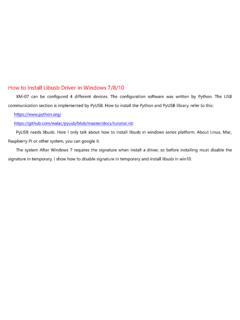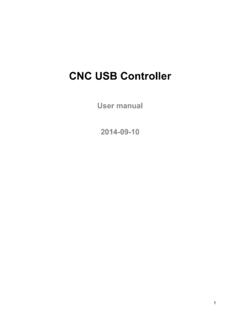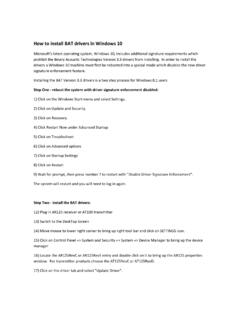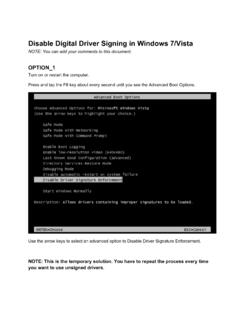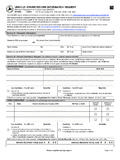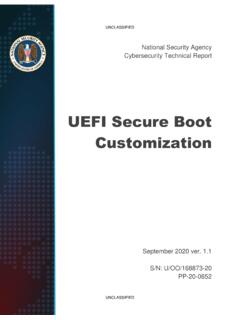Transcription of DSView User Guide - DreamSourceLab
1 DSView User Guide 1 Revision History The following table shows the revision history for this document. Date(DD/MM/YY) Version Revision 02/09/19 release for DSView 30/05/18 release for DSView 19/07/17 release for DSView 08/09/16 Initial release for DSView 2 Contents 1 Overview .. 5 Introduction .. 5 Download .. 5 Installing DSView .. 5 Operating System .. 5 Recommended Minimum Hardware .. 5 How to Install .. 6 User Interface .. 8 Device Mode .. 8 Language Switch .. 10 Theme Switch .. 10 2 Logic Analyzer .. 11 Hardware Connection .. 11 Hardware Options .. 13 Mode .. 13 Channel .. 14 Sample Duration/Rate .. 15 Sample Duration .. 15 Sample Rate .. 15 Trigger .. 16 Simple Trigger .. 16 Advanced 17 Capture .. 20 Normal Capture .. 20 Instant Capture .. 21 Capture 21 Navigating .. 22 Panning Left/Right.
2 22 Zooming in and Out .. 23 Pattern Search .. 23 Channel Customization .. 24 Measurement .. 24 Width/Period/Frequency/Duty Cycle .. 25 Pulse Counter .. 25 Edge distance .. 25 Cursor 26 Cursor Move .. 26 Cursor Jump .. 27 Cursor Measure .. 28 3 Delete Cursor .. 29 Protocol Decoder .. 29 Add Decoder .. 30 Stack Decoder .. 31 List Viewer .. 32 Search Results .. 33 Export Results .. 34 Delete 34 File Operation .. 35 Setting Store/Load .. 35 Save .. 35 Open .. 35 Export .. 36 Screen Shot .. 36 3 Oscilloscope .. 37 Hardware Connection .. 37 Hardware Options .. 38 Operation Mode .. 38 Auto 39 Manual Calibration .. 39 Capture .. 40 Channel Customization .. 40 Horizontal Resolution .. 41 Run/Stop .. 42 Single Capture .. 42 Trigger .. 42 Measurements .. 44 Auto Measurements .. 44 Y Cursors.
3 44 X Cursors .. 47 Manual 47 Spectrum Analysis .. 48 FFT Options .. 48 Navigating Spectrum .. 49 Math Function .. 50 Add Math Channel .. 50 Math channel .. 51 Lissajous Figure .. 52 Lissajous Setup .. 52 Lissajous View .. 52 File Operations .. 53 Setting Store/Load .. 53 4 Save .. 53 Open .. 53 Export .. 54 Screen Shot .. 54 4 Data 55 Hardware Connection .. 55 Hardware Options .. 55 Operation Mode .. 56 Channel 56 Capture .. 57 Capture Options .. 57 Start/Stop .. 57 Measurement .. 57 Cursor Measure .. 57 File Operations .. 60 Setting Store/Load .. 60 Save .. 60 Open .. 60 Export .. 61 Screen Shot .. 61 5 1 Overview Introduction DSView is a multi-function signal capture and analysis software. Its main function include logic signal capture and measure, digital protocol analysis and debug, analog signal real-time capture and measure, spectrum analysis, etc.
4 DSView is also an open source software based on sigrok project ( ), developed and maintained by DreamSourceLab ( ). Current version ( ) support three operation modes: Logic Analyzer, Oscilloscope and Data Acquisition. Until now, DSView support following hardware: DSLogic series logic analyzer DSLogic: 400Mx4/ 200Mx8/ 100Mx16 channels logic analyzer DSCope series oscilloscope DSCope: 200MS/s / 8bit / Dual Channels oscilloscope Download Installer: Source code: Installing DSView Operating System Windows XP / Vista / Win7 / Win8 / Win10 Linux Debian / Ubuntu, Fedora, OpenSUSE, etc. Apple OS X and above Recommended Minimum Hardware CPU: P4 and above Memory: 2G and above HDD: 20G and above USB and above 6 How to Install Windows a) If an older DSView software have been installed, please uninstall it totally including drivers b) If you have the old hardware, which have the following device name(DSLogic/DSLogic Pro/DSCope/DSCope20), and want to use DSView on WIN8 or above, please disable the driver signature enforcement before installing the software win8: win10: Install Steps: 1 Double click the Executable setup file.
5 2 Select setup language. 3 Click Next on welcome page. 4 Click I Agree on license agreement page, if you accept the terms of the agreements; otherwise, click Cancel to stop installing. 5 Choose install location, and click Install. 6 Waiting done. If following page appear (Figure 1-1), for the old hardware, which have the following device name(DSLogic/DSLogic Pro/DSCope/DSCope20), please select Install this driver software anyway Figure 1-1 7 Windows XP Please install the hardware driver manually on windows xp operation system according to the steps of Figure 1-2. This instruction will be popped up when running the installer on xp system. Figure 1-2 Linux Step1: Get the DSView source code $ git clone Step2: Installing the requirements: please check your respective distro's package manager tool if you use other distros Debian/Ubuntu: $ sudo apt-get install git-core build-essential cmake autoconf automake libtool pkg-config libzip-dev libudev-dev python3-dev qt5-default libboost-dev libboost-test-dev libboost-thread-dev libboost-system-dev libboost-filesystem-dev check libfftw3-dev Fedora (18, 19): $ sudo yum install git gcc g++ make cmake autoconf automake libtool pkgconfig glib2-devel libzip-devel libudev-devel libusb1-devel python3-devel qt-devel boost-devel check libfftw3-devel Arch: $ pacman -S base-devel git cmake glib2 libzip libusb check python boost qt5 fftw Step3: Building $ cd libsigrok4 DSL $.
6 8 $ ./configure $ make $ sudo make install $ cd .. $ cd libsigrokdecode4 DSL $ . $ ./configure $ make $ sudo make install $ cd .. $ cd DSView $ cmake . /* * If this step fails, * make sure that your pkg-config is properly configured * to find the libsigrok and libsigrokdecode libraries * (It's not by default in Fedora 23). * To do this add "export PKG_CONFIG_PATH="/usr/local/lib/pkgconfi g" * to your ~/.bashrc and reload it `. ~/.bashrc`. */ $ make $ sudo make install Mac OS X 1 download the dmg file 2 open the dmg, and drag DSView to Application directory. User Interf ace Device Mode Figure 1-3 shows the user interface of DSView under logic analyzer mode. 9 Figure 1-3 Figure 1-4 shows the user interface of DSView under oscilloscope mode. Figure 1-4 Figure 1-5 shows the user interface of DSView under Data Acquisition mode. Device Options Device Name Device Mode Channel Options Horizontal Res Wave Window Tool Dock Sample Rate Toolbar Help FFT Window Device Options Device Name Device Mode Channel Options Sample Duration Wave Windows Tool Dock Sample Rate Toolbar Help 10 Figure 1-5 Language Switch Figure 1-6 shows how to switch the UI language.
7 Help Language / English Figure 1-6 Theme Switch Figure 1-7 shows how to switch the UI theme. Display Themes light / dark Figure 1-7 Device Options Device Name Device Mode Channel Options Sample Duration Wave Windows Tool Dock Sample Rate Toolbar Help 11 2 Logic Analyzer Hardware Connection 1) Connect DSLogic to PC s USB port, and check the LED indicator has been lit up. In order to achieve the best data transfer performance, please use the original or short and good quality USB cable, connect to the native port of the motherboard, and try to avoid using ports of extended hub. DSLogic Figure 2-1 2) Open DSView software, check the LED indicator become green, and DSView show the correct device name. Figure 2-2 3) Connect the shielded fly wires to the external port of logic analyzer. Figure 2-3 shows the wire mapping of DSLogic Plus kit. Except for 16 signal channels, the CK channel is the clock input for state capture, TI channel is the external trigger input , TO channel is the external trigger output.
8 12 03478111215 CIOC hannel 0 Channel 15 Channel 14 Channel 12 Channel 10 Channel 9 Channel 8 Channel 6 Channel 5 Channel 4 Channel 3 Channel 2 Channel 1 Channel 13 Channel 11 Channel 7 CKTITO Figure 2-3 4) Connect probe clips to the signals being measured. For low frequency signal (<5 MHz), a common ground is enough (Figure 2-4 left). For high frequency signal, an independent ground connection for each channel is recommended (Figure 2-4 right). Figure 2-4 13 Hardware Options Click Options button (Figure 2-5). Figure 2-5 Device Options window will be opened (Figure 2-6). Figure 2-6 Mode Operation Mode: Buffer Mode: data are stored in the on-board memory, and transferred to PC when capture finished. This mode support high sample rate (up to 400 MHz) and 14 limited sample depth. RLE compression is supported in this mode to extend sample depth.
9 Stream Mode: data will be transferred to PC during the capture duration. This mode has limited sample rate and well sample depth. Internal Test: test only. Stop Options: Stop immediately: Under buffer mode, when stop during capturing, no data will be uploaded, current capture will be stopped immediately Upload captured data: Under buffer mode, when stop during capturing, data already captured in hardware buffer will be uploaded, and show on wave window. Threshold Voltage: 0-5v range and step. This feature will make the logic analyzer compatible to most of voltage standard. (old DSLogic hardware don t support this feature) Filter Targets: None: original capture result 1 Sample Clock: filter all pulse less than 1 sample clock time. Max Height: max display height of each channel. Enable RLE Compress: enable hardware compress.
10 Only available in buffer mode. Using External Clock: use external clock as the sample clock for state capture. Using Clock Negedge: use the falling edge of sample clock as the sample edge. Channel Channel Mode: In Buffer Mode Figure 2-7 For 100 MHz and below sample rate, all of 16 channels are available, for 200 MHz sample rate, only 0-7 channels are available, for 400 MHz sample rate, only 0-3 channels are available. In Stream Mode 15 Figure 2-8 If only 3 channels be used, the max sample rate is 100 MHz. If only 6 channels be used, the max sample rate is 50 MHz. If only 12 channels be used, the max sample rate is 25 MHz. If all 16 channels be used, the max sample rate is 20 MHz. Channel Enable: After channel mode set, each available channel can be enabled or disabled. Enable All will enable all available channels; otherwise, Disable All will disable all available channels.
